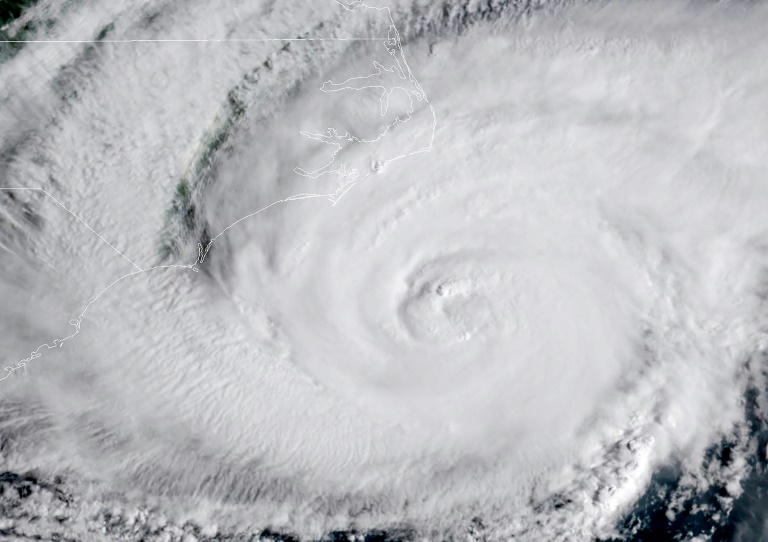
"Just because the wind speed came down, the intensity of this storm came down to a Cat 2, please do not let your guard down," warned Brock Long, administrator of the Federal Emergency Management Agency (FEMA).
Florence was downgraded to a Category 2 storm overnight on the five-level Saffir-Simpson scale but it is still packing hurricane-force winds of 105 miles per hour (165 kilometres per hour), the National Hurricane Centre (NHC) said.
Winds were already picking up along the coastline on Thursday morning and Myrtle Beach was virtually deserted with empty streets, boarded up storefronts and very little traffic.
"I was feeling fine until I woke up this morning and this is a ghost town," said Kristin Beard, a 40-year-old Myrtle Beach marketer. "I'm going to Charlotte."
Hurricane Florence closes in on US east coast
At 11:00 am (1500 GMT), Florence was over the Atlantic Ocean about 145 miles (230 km) east-southeast of Wilmington, North Carolina, and moving northwest at 10 mph (17 kph), the NHC said.
Steve Goldstein with the National Oceanic and Atmospheric Administration, said Florence's forward motion had slowed overnight and it was not expected to make landfall in the Carolinas for "another 36 hours."
"Sometime Friday afternoon, Friday evening or Saturday morning," Goldstein said.
He said hurricane-force winds extend outward 80 miles (130 km) from the centre of the storm and tropical storm-force winds extend nearly 200 miles (322 km) out.
A storm surge of nine to 12 feet (2.7-3.6 meters) was expected along the North Carolina coast, Goldstein said, and some areas could receive as much as 40 inches (one meter) of rain.
A tornado watch was also in effect for parts of North Carolina.
"This is a very dangerous storm," said FEMA's Long, urging people still in evacuation zones to heed orders to flee to safer ground.
"Your time is running out," he said.
Long said the danger was not only along the coast. "Inland flooding kills a lot of people, unfortunately, and that's what we're about to see," he said.
About 1.7 million people in North Carolina, South Carolina and Virginia are under voluntary or mandatory evacuation orders and millions of others live in areas likely to be affected by what has been described as the most severe storm to hit the region in decades.
South Carolina ordered the mandatory evacuation of one million coastal residents while North Carolina ordered an evacuation of the Outer Banks, barrier islands that are a popular tourist destination.
In Virginia, 245,000 coastal residents were ordered to evacuate.
Over a million told to flee as Hurricane Florence stalks US East Coast
A state of emergency has been declared in five coastal states: North Carolina, South Carolina, Georgia, Maryland and Virginia and the US capital Washington.
Duke Energy, a power company in the Carolinas, estimated that one million to three million customers could lose electricity because of the storm and that it could take weeks to restore.
"We call them disasters because they break things," said FEMA's Long. "The infrastructure is going to break, the power is going to go out."
North Carolina Governor Roy Cooper warned residents not to "underestimate" the storm.
"This storm will bring destruction to North Carolina," Cooper said. "Catastrophic effects will be felt outside the centre of the storm."
Not everybody was heeding orders to evacuate, however.
Antonio Ramirez, a construction worker from El Salvador living in Leland, North Carolina, said he planned to ride out the storm with his dog Canelo.
"The shelters are not taking dogs," Ramirez said. "I'm not leaving him here.
"But I'm not afraid," he said. "We're ready and God will watch over us."

1726117332-0/Megan-Thee-Stallion-(1)1726117332-0-165x106.webp)





















COMMENTS
Comments are moderated and generally will be posted if they are on-topic and not abusive.
For more information, please see our Comments FAQ